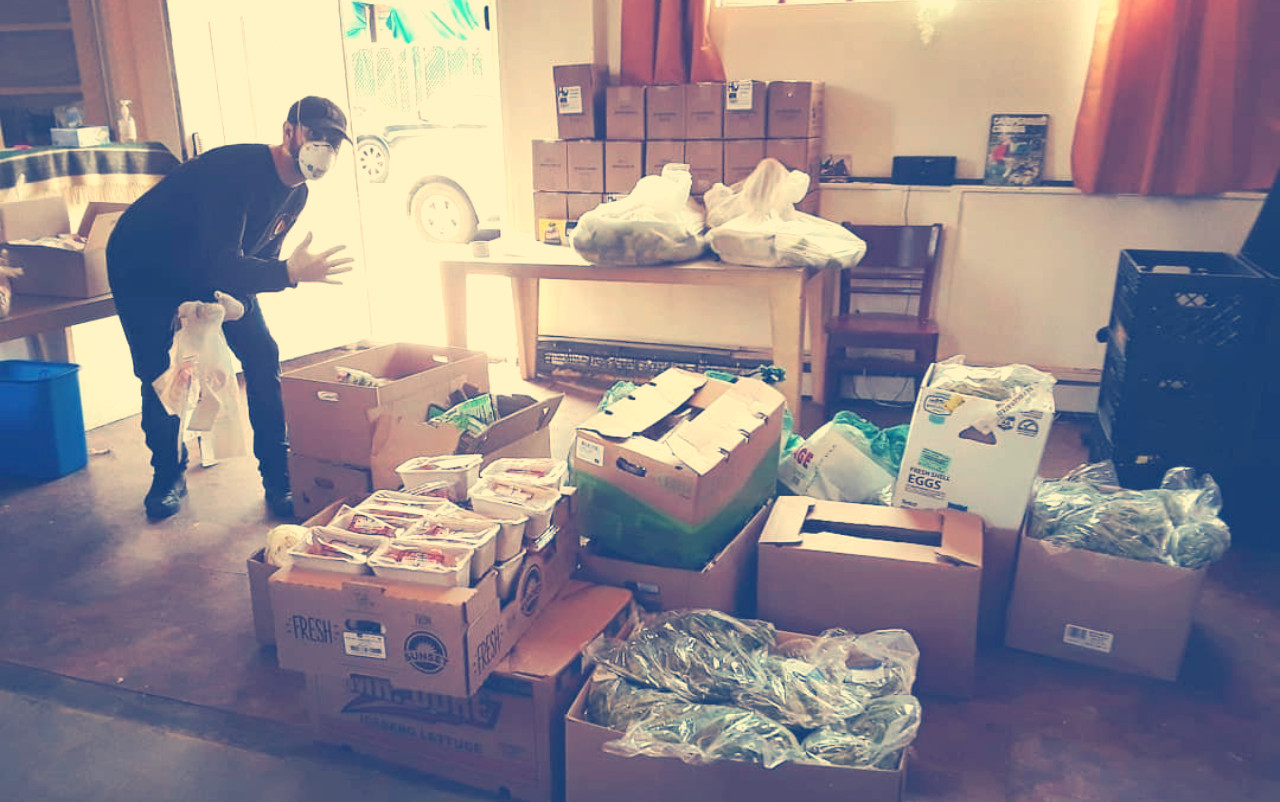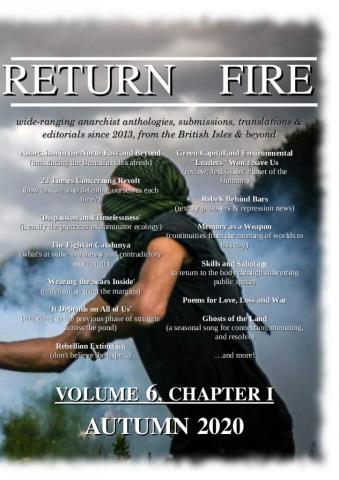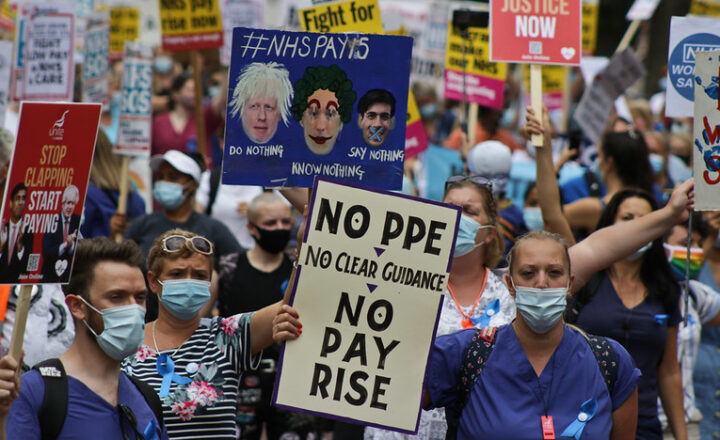Translated interview from the French publication Rouen Dans la Rue with the autonomous anti-capitalist space, Woodbine, located in so-called New York.
Solidarity everywhere is organized. It is not only a question of remedying the failings of the State, as we read too often. In the USA, Italy, France and probably elsewhere, there are autonomous collectives which existed before the current crisis, and which had already developed the habit of organizing outside of the State (and sometimes against it). These collectives are armed with a certainty: it is no longer possible to maintain the Left’s contradiction of, on the one hand, criticizing state policy and, on the other, returning it back to its fantasized mission of realizing the general interest. The State is an integral component of all the disasters in progress, and the current situation will certainly not prove otherwise.
We spoke to Woodbine, an autonomous space in New York City, with this question in mind: What does it mean to organize politically in the age of Trump?
Woodbine recently published a text on getting organized within the pandemic, “Mutual Aid, Social Distancing, and Dual Power in the State of Emergency.” They have since transformed their space into a mutual aid organizing hub for their neighborhood of Ridgewood, Queens, and have partnered with a local homeless outreach organization to start a food pantry. We’d like to now publish an interview conducted before the pandemic. It explores the history of the group and its influences, autonomy in America, territory, and organizing for the long-term.
Hello! Please introduce yourself and your group to us. Where do you come from?
Woodbine is an experimental hub in Ridgewood, Queens, a working class immigrant neighborhood in New York City. The collective that runs the space came together out of Occupy Wall Street and Hurricane Sandy in 2011-2012, both from our experiences within them as well as the depression and confusion that followed. Those events and the general responses to them were the dual inspirations in framing the beginnings of the space: to re-think and confront apocalypse and revolution. We started moving to Ridgewood in the Fall of 2013, with the idea that being in closer proximity to each other would better allow us to collaborate, to better be able to share our time and lives together.
A number of us knew each other for years before Occupy, having met in various movements – anti-globalization, anti-war, the student occupation movement in 2008-2010 – as well as in arts and film spaces, study groups, etc. But we were spread throughout the city in various neighborhoods and boroughs, sometimes living more than an hour away from each other. For years people had talked about trying to assemble in one neighborhood, to increase our density and capacity, to change our shared rhythms, to change our relationships to each other and the city. So this was the context for starting Woodbine in Ridgewood, which was opened as our headquarters for this experiment, and continues to be the hub for all the practices and encounters that stemmed from it.
What do you think about the recent developments within radical movements in the US? Do you think that the election of Donald Trump activated people?
Donald Trump was elected on November 8th, 2016, the same day our friend Clark passed away in a car accident on the way to the Standing Rock occupation. Clark was a co-founder of Woodbine, the director of our videos “A Resolution” and “To All Those Who Can’t Breathe,” the co-founder of the Ridgewood Community Garden, and a driving force in the move to expand Woodbine into upstate New York. In the immediate aftermath of Trump’s shocking victory we were too stricken with grief to actively participate in the protests, or even really to see or understand what it all meant. But these events did cause our community to deeply examine how we were organizing ourselves, what were we doing and why, what were our goals, who were “we” and how could we continue. To try to do all this in the wake of the new political reality and future represented by Trump was of course difficult and confusing.
Nationally, yes, people were activated by Trump’s election, though that activation generally took place in three domains, none of which really helped advance our political horizons. The first was within anarchist and anti-fascist organizing, from the protests around Trump’s inauguration in January 2017, to the regular street confrontations with a newly emboldened and visible white nationalist movement trying to piggyback on Trump’s victory. Though we should acknowledge that, if at first we were critical and cynical of the amount of energy being put it into antifa, it did successfully “deplatform” and de-legitimize explicit white supremacist organizing in the United States, which has effectively disappeared as a public phenomenon.
The second sphere of activation was the result of Bernie Sanders’ self-proclaimed “democratic socialism,” which significantly inflated the membership numbers of the DSA (Democratic Socialists of America). The organization grew from around 6,000 members in 2016, to 25,000 in 2017, and they now number around 50,000. This makes the DSA something like the largest radical organization in the United States in a century, made up of a strange combination of Marxist determinists, well-meaning activists, and opportunistic electoralists. It’s become near-hegemonic among the radical Left, absorbing tons of younger, newly politicized people, former members of micro-sects, attempted-entryists who end up just full-on members, and even anarchists and anti-fascists themselves.
The third site of activation was within the Democratic Party itself, as Trump’s electoral victory coincided with the Republican takeover of both the Senate and House of Representatives, as well as most state governorships and state legislatures. Trump winning provided a convenient alibi for the Democrats to shamefully position themselves as an opposition party, where anything and everything they did would be claimed as part of “The Resistance.” The DSA in a way has aided this growth, as even if they represent an insurgency both within and against the Democratic Party, ultimately and materially their strategy involves the devotion of an enormous amount of energy, resources, and money into the Democratic Party’s infrastructure, in the form of electoral, legislative, and policy campaigns.
All of this has sucked up a lot of attention, and taken away much of the momentum and clarity that existed within autonomous, experimental, forward-thinking organizing projects. Trump came to “activate” people in such a way that more traditional and institutional forms seemed better suited to oppose him, for better or worse. As much as Trump and Bernie came to shock and destabilize the political establishment, the result of those insurgencies has been a re-entry and reinvestment into that same classical form of politics.
What theoretical traditions do you see the collective within? Could you name three of the most important theoretical schools you rely on in your practice?
We have tried to avoid dogmatism as the basis for how or why we organize, as orthodoxy and sectarianism are primarily the things that drove us away from the Left, activist culture, and radical milieus. Our community came together out of friendships, shared experiences in movements, the recognition of a similar disposition towards life itself, more so than politics or a particular literature. The political framework that has guided the project has been around the question of autonomy, or maybe “dual power,” what it is, or means, or looks like in our context, in a city, in a neighborhood. How to experiment with building and sharing amongst a network, rather than an organization; how to build and maintain a community to sustain and grow, that can make all of this real.
The thinkers most foundational for imagining and starting Woodbine, whose writings were most explicitly or implicitly referenced in providing us a conceptual vocabulary, are probably Giorgio Agamben, Tiqqun, and The Invisible Committee. Together they’ve formed a school of thought in thinking communism outside of the Marxist tradition. Others include the Kurdish freedom movement in Turkey and Syria, the ongoing Zapastia experience of autonomy in Chiapas, and the Mohawk Warrior Society’s struggles for sovereignty in upstate New York and Canada, all of whom we made a point to visit in our first few years. We ourselves are not organizing on the basis of ethnicity, nor are we struggling for an ancestral homeland, so being in New York City we have benefited from being able to think through these questions with people like Ben Morea of the Motherfuckers, Kristin Ross, Fred Moten, Silvia Federici, as well as former members of the Black Panthers and Young Lords, all of whom have been influential for us, as well as supportive to what we’re trying to do.
As Woodbine is primarily a space there was also the influence of other spaces in New York that came before us in experimenting with forms of political and social organization. ABC No Rio was the first squatted social center I visited more than 20 years ago, which exposed me to the history and context of the Lower East Side squatting movement. It opened in 1980, and combined music, food, a library and archive, art, and served as a meeting space for truly out there people, especially for a teenager. Then there was the Brecht Forum, a Marxist cultural and educational center in the West Village which was really remarkable in its capacity to house intergenerational, multi-racial, rigorous, ecumenical programming on an almost daily basis. It started in the mid-70s, and housed three different meeting spaces, had a full-time staff of 3 people, and offered desk space to around a dozen small, radical organizations, campaigns, and publications. And 16 Beaver was an artist-run loft in the Financial District, it started in 1999 and hosted free, spontaneous seminars, screenings, and discussions, often while international thinkers or friends were visiting the city. The events were really free-form, durational, and included extended breaks to cook and eat together. These and other spaces in the city were as influential as any European theorists, as they were places where we were exposed to ideas and movements, where a number of us met each other in the years before Occupy–they were spaces which tried to combine politics, art, and life.
These places were also all in Manhattan, and all closed around the same time in 2014, right when we were getting started. Being in Lower Manhattan meant they could serve as accessible nodes for the entire metropolitan area, but as real estate pressures changed the political and cultural geography of the city, it forced similar projects out into Brooklyn and Queens. Woodbine opening in Ridgewood meant we were situating ourselves in a peripheral, residential neighborhood of the city, which necessarily set us on a different track.
What do you think would be important steps for the autonomous movement in the United States?
We have to try to understand and theorize truly and deeply what autonomy is, and then understand ourselves as a movement working towards it. “Autonomy” runs the risk of becoming a buzzword, jargon, just like revolution and insurrection, or “communization,” an empty signifier meaning everything and nothing. To lose the grasp of words is another form of dispossession, and so becomes another terrain of struggle. Liberty, freedom, independence, these terms were able to motivate and inspire movements throughout history to fight for dignified lives.
What makes our vision, strategy, and approach distinct, and how to make that legible as a joinable, replicable phenomenon, both to ourselves and others? What and who brings vitality, charisma, confidence, and capability to our movement, makes it seductive, gives it strength? We have to be able to reflect seriously and honestly on the last 5, 10, 20, 50 years of organizing we’ve experienced, not in a mode of critique and cynicism, but to really learn from what we’ve done, tried, and thought through. So listening, studying, being humble, a performative bravado won’t be enough.
Self-determination, self-organization, self-sufficiency, they begin from the premise of some self that knows who it is and what it wants, but this subjective and existential terrain is our most precarious and desperate – from where do we find a mental strength, certainty, and confidence? How do we see ourselves within a lineage and trajectory stretching back for decades and centuries, and then projecting forward for generations? This can be more unimaginable than anticipating the next riot, blockade, or occupation – to really know ourselves and what we are struggling for.
You talk a lot about the question of territory, what does territory mean for you? What are the long term perspectives?
Territory evokes something beyond a building we pay rent to access, a street we didn’t pave, a neighborhood whose administrative boundaries we didn’t decide on, so we can imagine a different way of relating to the place we find ourselves in. Our strategy was to collectively self-organize in a neighborhood together, to simultaneously research and understand its specific history and context, while also trying to invent something new, to build and develop our own landmarks and points of meaning. For us “territory” refers to this creation of place as both a spatial and relational field of shared gestures, habits, and rhythms taking place between people. How does a group of people come to inhabit a place together, to create a new meaning in being somewhere together, which then inscribes the place itself. In A Thousand Plateaus Deleuze and Guattari speak of deterritorialization and reterritorialization, as processes and operations that happen to us historically, spatially, and metaphysically, but that we can also interrupt and redirect. In our own Nomos of the Earth we wrote, “territory is not just a place on a map. Autonomy speaks to our becoming powerful through the weaving together of the necessary links between us, building up and in fact becoming the territory. Territory emerges out of a collective acting together, and disappears when that ceases. As such it requires care, attention, creation, and organization. It is not something that is just there. Territory is an act, it is to be built.”
When it comes to temporality, most of us live in different places than our parents, grandparents, and ancestors, whether it’s new continents, countries, cities, neighborhoods, or all of the above. For various political and economic reasons, from wars and poverty, to famines and dictatorships, we can’t claim a direct historical lineage to the spaces we find ourselves in. We also don’t own the places where we live and organize, they don’t carry with them memories and stories so easy for us to access. Without any of this as a foundation, it’s incredibly challenging to project ourselves with any certainty into the future. This is our precarity in the present, hurled into the world, bouncing around cities and institutions, neighborhoods and apartments, with all of their contingent relationships, and trying to grasp hold onto anything which might give us meaning and strength. In anchoring our efforts and lives to a particular place we hoped to share something that might unleash possibilities we couldn’t have anticipated. Woodbine is entering its 7th year, and when we started we didn’t seriously think very far into the future. Even after the first year there was still the question, would we renew the lease, how would we find the money to pay for everything. Only as we’ve gone on have we started to think more institutionally, with longer term plans, commitments, and the ability to organize materially for the resources we need to continue. This has also meant having a sense of our own organizational legacy, breaking from the activist temporality of some new position, obsession, or cause every season.
What are other promising radical projects in the United States?
In September a new organization called Symbiosis had its first congress in Detroit, Michigan. It’s a national confederation of local groups organizing around the frameworks of dual power and municipalism, and Woodbine attended as a member organization. Symbiosis has been largely anchored by Cooperation Jackson, a Black-led organization based in Jackson, Mississippi, made up of people coming out of the Republic of New Afrika and the Malcolm X Grassroots Movement. In some ways Cooperation Jackson represents a turning away from a Maoist national liberation framework and toward, in similar trajectories to the Zapatistas and the Kurdish movement, a new emphasis on cooperative and solidarity economies, and assembly-based democratic organizing structures. Their model has been really exciting and inspiring for a lot of people, and Symbiosis has been an attempt to combine that practice of building localized material forms of dual power, alongside American Bookchinites. There have been municipalist, social ecology networks active since the 1970s, but they have been given a real boost from the post-Rojava, post-Ocalan rise in visibility for Murray Bookchin’s ideas.
One of the challenges for Symbiosis is that a lot of its membership overlaps with the Libertarian Socialist Caucus (LSC) of the Democratic Socialists of America. Many anarchists and left-communists joined the DSA in the last few years, and for the most part they have been self-organizing as part of the Libertarian Socialist Caucus. So a new, separate organizational framework like Symbiosis has to contend with the totalizing effect the DSA has had on Leftist organizing in the country. The other issue for Symbiosis is the Bookchinites have a tendency towards fetishizing the formalistic, bureaucratic, administrative aspects of “direct democracy,” rather than the material and ethical aspects of living and practicing dual power.
Woodbine has a number of sister spaces around the country we share ideas and practices with, including Tamarack in Oakland, California; the South Bend Commons in Atlanta, Georgia; Flyover in Carbondale, Illinois; and 115 Legion in Olympia, Washington. All are public-facing, collectively run, autonomous hubs, facilitating communal experiments by groups of friends to create a situated political sensibility. We all take on varied forms, but the promise is in our shared consistency.




